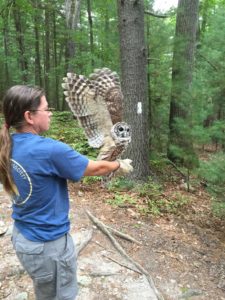
Above photo by Aura Stauffer: A northern black racer eating a timber rattlesnake is one of the many unexpected things I’ve witnessed during my woodland travels.
Where are your favorite places in Pennsylvania to see wildlife? This seems to be a question that I get asked a lot these days. I struggle with an answer for two main reasons. One reason is that I am a wildlife biologist working for DCNR, Bureau of Forestry. As part of my job on state forest lands, I conduct and assist with surveys for animal Species of Concern like bog turtles and timber rattlesnakes. As much as I’d love to show people these sites and capitalize on educational opportunities for the often misunderstood reptiles of this Commonwealth, the location of these sensitive sites must be protected.
I blame the COVID pandemic for my second reason. Rachel Carson said, “It is a wholesome and necessary thing for us to turn again to the earth and in the contemplation of her beauties to know the sense of wonder and humility.” Faced with the lockdown and limited recreation and vacation options, many people did just that in 2020. People flocked in record numbers to their local state parks and forests. Many were visiting them for the first time. I am hopeful that in doing so, people discovered a new sense of “wonder and humility” for nature. Unfortunately, the large crowds meant that some places like The Seven Tubs Natural Area in the Pinchot State Forest were loved a little too much. The unscrupulous behavior of a few individuals ruined the experience for many state forest visitors. This fact and the amazing influence of social media makes me very wary of directing people to any specific areas.
In my attempt to dodge a direct answer to the question of my wildlife viewing recommendations, I will be more general and share a story from a visit to one of my favorite remote state forests in northern Pennsylvania. I was searching for new timber rattlesnake basking and gestation sites. On my way up the mountain, I encountered a beautiful hemlock stream and ravine. As I walked along the stream, I heard a noise on my left side of something traveling through the woods towards me. I couldn’t see what it was because the stream bank was 10-feet high. Fully expecting to see a bear, I quickly hid behind a large hemlock and hoped for the best. To my astonishment, a whole family of coyotes paraded past, complete with mom, dad, and several pups crossing the stream. It was like watching a nature show. They didn’t know that I was there until the very end when one of the pups looked in my direction and made a “yip” sound to warn the others. One of the adults circled back barking at the pup and then they disappeared.
 What is the moral of the story? Go get a map, a GPS or smartphone app, and a compass (yes a compass) and then pick a trail on the map that looks interesting. Make your own adventures while using Leave No Trace principles. Who knows what wildlife you’ll discover!
What is the moral of the story? Go get a map, a GPS or smartphone app, and a compass (yes a compass) and then pick a trail on the map that looks interesting. Make your own adventures while using Leave No Trace principles. Who knows what wildlife you’ll discover!
Written by Aura Stauffer, Wildlife Biologist with the Pennsylvania Department of Conservation & Natural Resources Bureau of Forestry, Ecological Services Section




